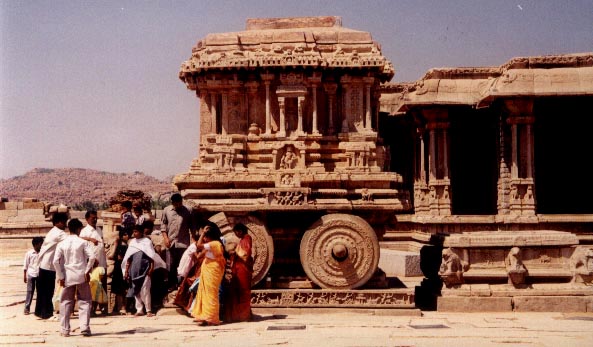
India March-April 2004
Everything you've heard about India is true, and if you've heard conflicting stories then it's all even more true. It may well be the most spectacular place on Earth, bursting at the seams with colour and ornamentation and tradition. And it's also without any doubt the most unpleasant, frustrating and filthy place as well. It's a land of opulent wealth, and of desperate poverty. It is a centre of spirituality, but touts on the street will sell their souls for ten rupees. People speak clearly, openly and with conviction, but at the end of my trip, I was farther from understanding Indians than when I arrived. The caricature of the enigmatic Professor Godbole in E.M. Forster's A Passage to India turned out to be surprisingly astute. Travellers I met who had spent almost a year in India still didn't understand why India is and how it really functions. Second generation Indians born abroad and returning to visit couldn’t understand India or Indians either. Even Mahatma Gandhi, upon returning from law studies in England, wrote frustratingly about the squalor and dishonesty and selfishness he found himself re-immersed within. Later in his quest to emancipate India from colonial rule in a nonviolent manner, he treated himself and his own body with such self-directed violence that it gave me pause to reflect upon the cultural roots of his attitudes and beliefs.
I fully believe Jung's tenet, vis-a-vis parenting, that what you say is meaningless but what you do conveys true meaning. Well, even if you discard everything that is said to you in India, which is incidentally not an altogether inefficient way to go in India, and only consider their actions, it still doesn't make much sense. The sheer illogic of the culture probably demands a thorough understanding of the Hindu religion, the fatalism of the castes, and of family values. Perhaps one has to grow up in a family there, as in Japan or in France, to fully comprehend and appreciate and agree with the fundamental cornerstone principles of the culture. I realize now that even if I was to spend years in India, I probably wouldn't develop a firm grasp of the most subconscious and primal facets of Indian culture.
The family is sacred in India and perhaps the only paradigm in which to detect great warmth over a background of unforgiving coldness. It's not that people dislike you or each other, because they don't. They just don't really care. You the tourist are there to give them money and your wellbeing and value as a person is entirely immaterial otherwise. I realized over the weeks there that this wasn't due to poverty -- I have travelled in poorer countries which exude a most empathetic warmth to all other people. Empathy, however, was curiously, and for me sadly, missing in this land. It is the single factor which would prevent me from wanting to live there, and the single factor which would make me reflect carefully over another visit in the near future (when there are so many wonderful, and more pleasant, places to visit in the world). This is India, and it has to be reckoned with on its own terms. When the visitor arrives, he or she slides into playing a histrionic role in this pageantry of the ages. It is certain that at various moments during the trip the tourist will be astounded, whether in amazement, wonder, disgust, surprise, or anger, and that is the novelty of visiting India.
One simply has to see for himself. There are numerous travellers and expats who adore India, coming back every year or staying years at a time. The travel loyalty that India can engender in some people (often Brits) is remarkable. I'd never seen such a passionate devotion to other developing regions, such as Latin America or East Asia or Africa. Perhaps only the Middle East comes close, and indeed I found many cultural similarities between India and the Middle East, far more than I expected in any case. The Himalayas and Hindu Kush mountains separate west Asia from east Asia not just geographically but in even more striking fashion culturally as well. Having a cultural affinity or fascination for a particular culture must surely be a highly subjective matter, where introspection into one's own persona is infinitely more revealing than commenting about the attributes of a given land. I can say for myself that Indian culture, beneath all the superficial pleasures and annoyances, is fundamentally not compatible with my own personal culture and values, and I say that without any prejudice or judgment or lack of appreciation for what India does have to offer.
In thinking out this web page, I had initially thought to include a litany of anecdotes describing experiences that I had and those of other travellers whom I encountered during the course of the trip. These stories would be certain to shock, amuse, horrify, and disgust the reader. Friends that know me well realize how tempting that would be for me! But in the end, it doesn't accomplish much and so I will refrain from recounting even the most graphic of incidents. While I am confident the stories would well illustrate some of the conclusions I've come to about India, some of the conclusions themselves might be construed as so unusual that no intelligent person (not having visited India) could buy them at face value anyway, with or without anecdotal examples. India is so unorthodox compared to any other destination I've visited that I can only impel you to visit for yourself to draw your own conclusions, and they may well be contrary to mine. This is one truth that I think everybody who has travelled in India can agree with me upon.
PART ONE: THE WEDDING
I just saw Kill Bill volume 2 this week, and fortunately I can report that the outcome of the wedding between Amar and Delphine had quite a different ending. Both bride and groom walked away happy and in good spirits. This 6 March wedding in Hyderabad was the reason that I came to South Asia more or less immediately after travelling for 3 months in Mexico and Central America. Seeing as March-April is a decent time for travelling and trekking in South Asia, before the oncoming monsoons and draining heat, it was a good opportunity for me to see this part of the world, and not have to cross back over the Himalayas from North Asia later in my travels. The 36 hour flight from San Francisco, counting 3 major layovers and 12 and a half time zones en route, reminded me that India is pretty much on the other side of the world from North America. While I had trouble staying awake for all of the ceremony, the wedding didn't disappoint. Sarees, hindu priests, and the mixed group of Indian and French guests all contributed to the colour of the low key two day event. The astrologer-declared wedding time of 11:14 am was perfectly achieved and a hotel reception in the evening featured tasty south Indian dishes and dancing to hair-raisingly off-key musicians. By the next morning, most of the guests had cleared off to continue their vacations in adjacent sites in India such as Madurai, Pondicherry, Goa, or Kerala.
Since I hadn't reflected at all on where to go next, I took a day to research destinations from a travel guide that a friend gave me at the wedding. It dawned on me fairly quickly that 1) the points of interest in India are scattered all across the vast, expansive country and 2) getting from one point to another efficiently simply is not possible. The cheap, comfortable and extensive rail network is the traveller's saving grace in India -- without it, long term travel is simply not feasible without great discomfort or great expense. Indian Railway's Trains at a Glance publication is indispensable for organizing trip logistics, and after learning the tricks of train travel, it soon became manifestly clear to me how flexible and powerful moving around India by rail really is. It may, in the final calculation, be the most valuable and tangible legacy of British colonial rule that endures in this timeless land.
So, with the grim realization that 5 weeks would clearly not be enough time to see what I wanted to cover in India without some personal sacrifice and hardship, I embarked upon a suicidal opening transport salvo toward the southern tip of India. It would be two overnight train rides followed by one overnight bus ride, spliced in with daytime visits to the ruins of Hampi, the British colonial retreat of Mysore, and an 8 hour boat ride on the serene Kerala backwaters before I would be able to sleep on another bed. It was a tough haul, but it enabled me to subsequently proceed northward into historical India with enough negotiable time to spend later in places that I wanted to savour more fully. In this case, it worked out well.
The ruins at Hampi are justly popular among the backpacker set, especially among younger European travellers who enjoy hanging out in some place for weeks. The lifestyle is simple and mellow, the eerie moonlike boulderscape of the surrounding countryside beckoning you to roam out into the forlorn desert. The outlying medieval temple ruins can be reached on foot or on bicycle for those willing to brave the dry heat. For me, the UNESCO World Heritage site of the 16th century Vittala Temple was the highlight, featuring the most intricate stone carving and the finest state of preservation in the region.

The wheels of the stone chariot at the Vittala Temple near Hampi were once capable of turning.
The hill station of Mysore is dominated by the Maharajah's Palace, the opulent seat of control of the former kingdom of Mysore. While it is a cool and pleasant town, and the palace strikes a regal pose by day and more so by night once a week when the 97,000 mounted lightbulbs come to life, there was nothing that commanded my immediate attention here. The nearby city of Bangalore has become a hub for the burgeoning Indian high tech and software sector (dubbed Cyberabad), and it appears that its wealth has trickled over into Mysore and Karnataka state in general. Life appears comfortable and the British colonial buildings impart a genteel feel to Mysore. From here, a hair-raising 12 hour bus ride over the mountains would deliver me onto the Arabian sea coastal plain and its humid heat. Though I was able to commandeer my own row of seats on the bus, sleeping proved difficult over the bumpy roads that threw my body clear into the air several times. My back did not forgive me for this bus ride for days afterward.
Upon arriving in the city of Ernakulam, one of the boroughs of Kochi, I quickly changed buses to head further south to Aleppey, one of the major port towns on the backwaters of Kerala state. This network of inter-connected rivers, lakes and canals, serves as the arteries and veins of local life in this waterlogged region graced with few roads. Tourists are coming in increasing numbers to enjoy the serene, timeless atmosphere of the Kerala backwaters, whether on cruises or spending time on a rented houseboat plying the calm waterways. Villagers bathe and play and wash their clothes in the backwaters, children run along the bankside causeways, and commercial pole-boats transport goods between villages. This has become for many the iconic image of the easygoing life in southern India.
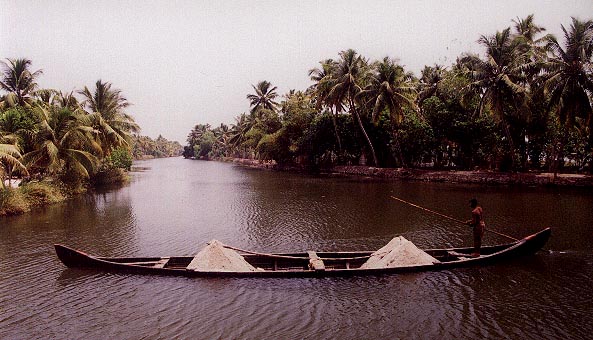
A boat transporting sand crosses a canal at a T-junction in the Kerala backwaters.
Further south toward Kollam, the eventual landing port of the cruise boat, the narrow waterways widen into larger bodies of water which mix fresh water with salt water from the sea. Here I had my first sighting of the graceful, almost animate, chinese fishing nets. These self-standing wooden structures, which lower and raise an attached net by an elaborate human-powered system of cantilevers, were first obtained by traders from the court of Kublai Khan and I am not aware of any other place in the world still operating these crane-like beasts. I found cruising down a trajectory flanked by these fishing nets lined up one after another quite exhilarating. I would later see more nets set up on the harbour of Kochi, the city where I would finally sleep on a bed after 4 consecutive days of deprivation!
The more historic districts of Kochi, Fort Cochin and Mattancherry, are rundown but clearly betray their Portuguese colonial origins in their colourful, red-roofed houses. Fort Cochin is the classy tourist ghetto where the oldest buildings (including the oldest church in India) and most hotels are situated, but it lacks the dynamic, gritty flavour of the nearby Mattancherry borough, a working class warehouse district and site of a Jewish quarter and synagogue. The best part of Fort Cochin is the fishing port, where you can eat fresh fish basted with spicy Indian sauces and grilled at smokehouse shanties set up alongside the boardwalk. Otherwise, restaurants in the neighbourhood are overpriced and cater only to tourists.
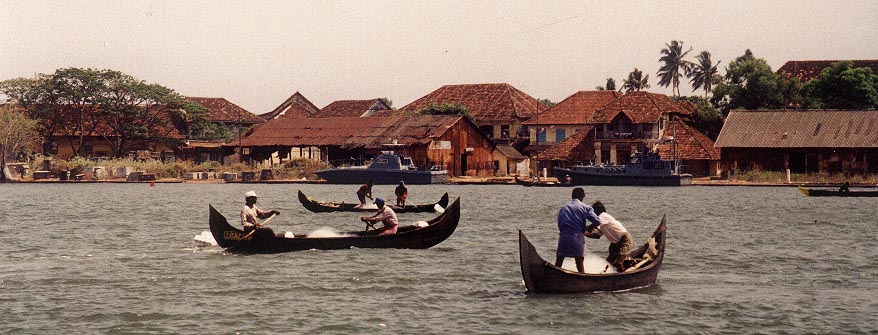
Fishing boats in the harbour of Mattancherry, Kochi.
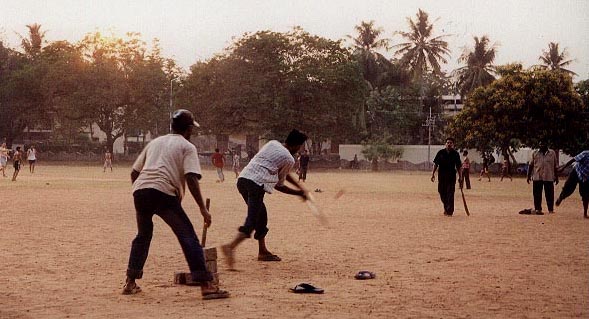
Cricketers bowl and bat on the Parade Ground of Fort Cochin, Kochi. There is no sport in India nearly as popular, and the ongoing Indo-Pakistani series of one day internationals drew fanatic crowds to every public TV set in the country.
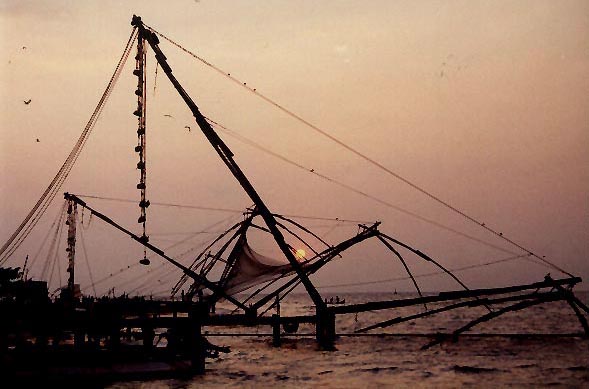
Chinese fishing nets operate at dusk in Fort Cochin harbour, Kochi.